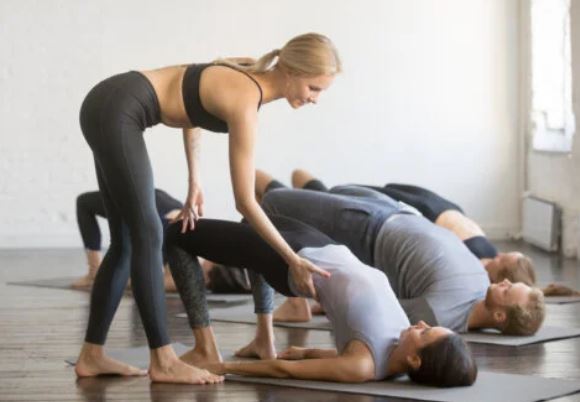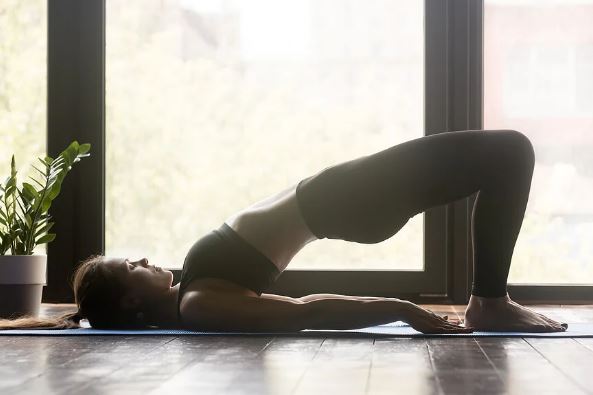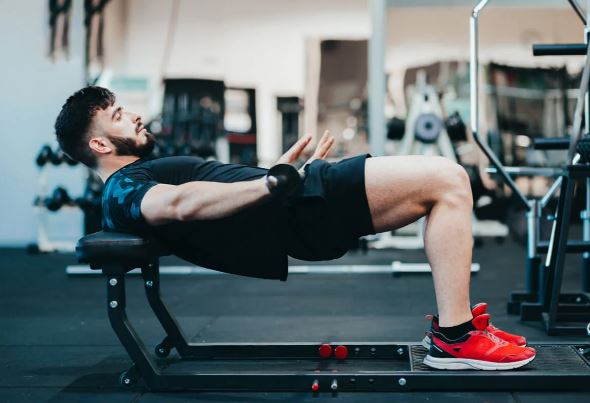The glute bridge is a complete lower body exercise that can be modified. In this article we show you some variations to add to your routine.

The glute bridge is a very comprehensive lower body exercise that works the abs, glutes, hamstrings, and pelvic floor. This move is ideal for improving hip mobility and strengthening the lower back. To get more benefits, you can vary the glute bridge in different ways.
The basic is done by lying on your back on the floor, with your knees bent and your feet supported. From here, keeping your arms at your sides, palms down, raise your hips until your knees, hips, and shoulders form a straight line.
Here the glutes are squeezed hard, keeping the abdominals contracted so as not to over-extend the back during the exercise. Hold the bridge position for a couple of seconds before going back down.
The glute bridge is an exercise that can be performed in any toning routine. In addition, it is present in disciplines such as yoga and Pilates.
Glute Bridge Variations You Can Try
The glute bridge, by itself, is already a good toning exercise. However, variations can be made for additional benefits, making it more intense and challenging.
To vary the gluteal bridge, you can use extra equipment (such as balls or rollers) or not use any additional equipment. Here are some of the more interesting options.

Yoga and Pilates use the glute bridge as a movement. Its variations add complexity.
1. One leg glute bridge
This is a very simple way to vary the glute bridge, but at the same time it is challenging. It requires much more work on the supported leg and abdomen, while requiring additional work on the unsupported limb.
To do the glute bridge on one leg, lie on the floor on your back and bend your knees, resting your feet on the floor. Then lift one leg up straight, with your thighs parallel to each other.
Next, push your hips up until your body is in a straight line from the shoulders to the toes of the extended foot. Go back down slowly and repeat on the same side. After doing 8 or 10 repetitions, switch legs.
2. With raised heels
Another way to vary the glute bridge is to do it with the heels elevated. This involves the work of the rectus femoris, the vastus lateralis, the vastus medius, and the sartorius.
The glute bridge with elevated heels is done in the same way as the traditional bridge, but keeping the heels elevated at all times. Unable to count on momentum, the lift requires more effort in the gluteal area and a more intense contraction of the core muscles.
3. Buttock bridge over heels
In this variation of the gluteal bridge, what we do is support ourselves only on the heels, raising the front of the foot. This modifies muscle activation and helps to involve or increase the work of the biceps femoris, semitendinosus, gracilis or internal rectus, gluteus maximus and gluteus medius.
The procedure is the same as in the previous exercise, but avoiding supporting the toes. Only the heels are used for support.
4. Buttock bridge with medicine ball
The medicine ball glute bridge is performed by placing your feet together on a medicine ball to challenge balance. The primary challenge has to do with the curved surface of the ball. Also, having your feet together makes it more difficult to keep your hips up.
5. With roller
Supporting your feet on a roller is another variation of the glute bridge. It is a little easier because the feet can be supported in their normal width, but the instability of the roller and the scarce base of support make it very difficult to concretize.
6. Buttock bridge on bench
To further increase the effort of the basic glute bridge, try placing your feet on an exercise bench, chair, or box. This will allow you to raise your hips much higher and be more challenging. Also, you can do all the variations without equipment already explained.
7. Barbell glute bridge
Place a barbell on your upper thighs and hold onto it. You can put weight on it or use just the barbell itself. Holding the bar will cause you to lose support, which will increase the difficulty.
8. On bench and drawer
Stand with your back on a bench and your feet on a drawer higher than the bench. From there perform the basic exercise. You will see that the challenge is important and that stability requires attention, because it is compromised.

The weighted variants of the glute bridge add difficulty and involve greater balance to support the element.
Assess your abilities to vary the glute bridge
The basic glute bridge is not a difficult exercise to do, but it does require a certain level of resistance. In addition, it is important to keep in mind that technique is essential to prevent injuries.
For example, if the core and pelvic floor muscles are not being properly activated, exercise is stressful for the lower back. In addition, if there is any type of pain or injury in the back, especially in the lower area, it is important to avoid this movement until the discomfort subsides.
As for the variations, it is important to include them with caution in the routine and only execute them as our physical form and resistance allow it. It is much better to do the basic exercise with more reps and sets than to include a harder one.





